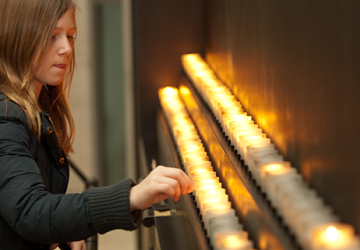Marking International Holocaust Remembrance Day: January 27
The United Nations General Assembly chose January 27 for the annual commemoration because on that date in 1945 the Soviet army liberated Auschwitz-Birkenau.

A girl lights a candle at the U.S. Holocaust Memorial Museum in Washington, D.C. Image Source: U.S. Holocaust Memorial Museum
Today, January 27, is International Holocaust Remembrance Day. The United Nations General Assembly chose January 27 for the annual commemoration because on that date in 1945 the Soviet army liberated Auschwitz-Birkenau, a notorious German concentration camp.
The goals of Remembrance Day are to honor the more than six million Jews and millions of others — Poles, Roma, the disabled, homosexuals – slaughtered by the Nazis, and to promote Holocaust education. The hope is that by remembering the atrocities and the political path that led to them, and by educating the public about these events, the exclusion and genocide of any ethnic group in the future will be prevented. This year, 32 countries are hosting events.
Today is also a good day to pay homage to the “Righteous Among the Nations.” Israel gave this honorary title to those non-Jews who risked their lives during the Holocaust to save Jews from death.
Many sites domestically and internationally provide information about the Holocaust, the Righteous, and the importance of resisting the oppression of any group. Among them are the U.S. Holocaust Memorial Museum, Washington, D.C., and the NS Dokumentationszentrum, (Munich Documentation Center for the History of National Socialism), Munich, Germany.
U.S. Holocaust Memorial Museum
The permanent exhibition traces the rise of Germany’s Nazi party starting in 1933 and events that led to race laws, the creation of Jewish ghettos, and the “final solution,” the extermination of Jews. The exhibits are moving, difficult to watch, and powerful, especially, for me, the ones that enable viewers to see and hear the victims.
In the Tower of Faces: The Ejszyszki Shtetl Collection, hundreds of photographs of residents of this village line a red brick tower shaped like a smokestack. The inhabitants are sitting with friends, playing with children and going on picnics. The Nazis massacred all of these people. Survivors relate their concentration camp experience in videos and on tapes you can listen to. How crazed was Joseph Mengele? Look at the photographs of his “medical experiments.”
The permanent exhibit also pays homage to the “Righteous,” describing the residents of Le Chambon-sur-Lignon, a French village, who worked together to hide Jews, as well as the Danes who hid Jews in fishing boats, bringing them to safety.
NS Dokumentationszentrum
The National Socialist Party (Nazi party) began in Munich. The Munich Documentation Center for the History of National Socialism uses photographs and copies of newspapers and other documents to prove that Munich’s citizens and other Germans knew about the ostracism, deportation and eventual death of its Jewish citizens, and other Jews during the Holocaust.
To alert visitors to the dangers of excluding minorities, one of the museum’s last exhibits pairs a touch screen and a news ticker that report current examples of persecution of minorities throughout the world. This exhibit and the museum serve to underscore the fact that unless the rights of all, including minorities, are upheld, atrocities such as the Holocaust can — and are – happening again.
ACTIVA BioACTIVE Bulk Flow Marks Pulpdent’s First Major Product Release in 4 Years
December 12th 2024Next-generation bulk-fill dental restorative raises the standard of care for bulk-fill procedures by providing natural remineralization support, while also overcoming current bulk-fill limitations.